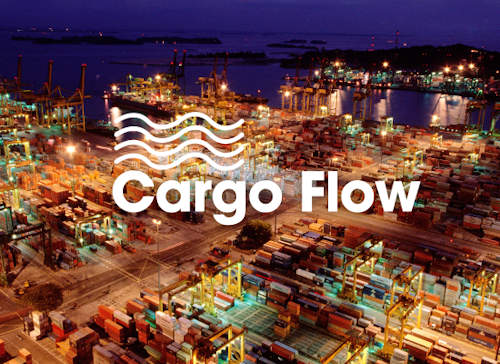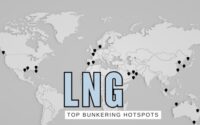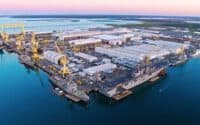Optimizing Cargo Flow: Best Practices for Efficient Port Operations

Port congestion has led to millions of dollars in losses for shipping companies and disrupted supply chains worldwide. Efficient cargo flow is crucial for minimizing delays and maximizing throughput at ports. When cargo moves smoothly, everyone benefits: shipping companies save money, ports operate more efficiently, and supply chains remain intact. Optimizing cargo flow is not just about moving goods faster; it’s about improving the overall efficiency and profitability of maritime operations.
* Please send feedback/suggestions to editor @ shipuniverse.com
In this article, we will explore several key strategies to optimize cargo flow at ports:
- Implementing Advanced Technology: Leveraging automation, digital twins, and IoT for real-time data and decision-making.
- Enhancing Infrastructure: Modernizing facilities and expanding capacity to handle increased volumes.
- Streamlining Processes: Improving cargo handling procedures and yard management for quicker turnaround times.
- Enhancing Collaboration and Communication: Coordinating effectively with all stakeholders to ensure smooth operations.
- Adopting Sustainable Practices: Implementing eco-friendly and energy-efficient practices to reduce environmental impact.
- Continuous Improvement and Innovation: Monitoring performance and embracing new technologies and practices for ongoing improvement.
By adopting these strategies, ship and fleet owners can significantly enhance their operations, ensuring that ports remain efficient and capable of handling the demands of modern maritime logistics.
Understanding Cargo Flow
Efficient cargo flow is crucial for economic and operational reasons. It maximizes throughput, minimizes turnaround times, and significantly reduces the costs associated with shipping and receiving goods. For ports, it translates into higher revenues and better service quality, while for ship and fleet owners, it means less time at port and more time on the move, directly impacting their bottom line.
Challenges in Cargo Flow
However, optimizing cargo flow is often challenged by various factors:
- Congestion: Ports can become overwhelmed with traffic, leading to significant delays. Congestion usually occurs when ports handle more cargo than they can efficiently manage due to limited space or resources.
- Delays and Bottlenecks: These often occur due to inefficient cargo handling procedures or operational inefficiencies within the port. Bottlenecks can specifically occur at loading docks, container storage areas, or customs clearance points, slowing down the overall cargo flow.
- External Factors:
- Weather Conditions: Severe weather can disrupt port operations, delaying cargo handling and shipments. Fog, heavy rain, or storms can halt operations, leading to backlog.
- Regulatory Changes: Changes in customs regulations or new security measures can introduce delays as cargo undergoes additional checks.
- Global Trade Fluctuations: Sudden increases or decreases in global trade volumes can strain port capacities and resources, affecting their ability to manage cargo flow efficiently.
Navigating these challenges requires strategic planning and the adoption of advanced technologies and processes to enhance the resilience and efficiency of port operations.
Implementing Advanced Technology
Automation and Robotics
The integration of automation and robotics into port operations has revolutionized how cargo is handled, significantly enhancing efficiency and reducing human error. Automated cranes, self-driving vehicles, and robotic loaders can operate continuously, minimizing downtime and speeding up the loading and unloading processes.
Case Studies of Successful Automation:
- Port of Rotterdam: This port employs automated guided vehicles and robotic cranes that operate independently, drastically reducing the need for manual labor and speeding up cargo handling.
- Port of Singapore: Known for its high degree of automation, this port utilizes unmanned, automated cranes and vehicles to manage its high cargo volumes, ensuring fast processing times and reduced congestion.
Digital Twins and Simulations
Digital twin technology involves creating a virtual model of the port that can be used for planning and optimization. It allows port operators to simulate different scenarios and their impacts on cargo flow, helping to identify potential bottlenecks and optimize operations before implementing changes in the real world.
Examples of Digital Twin Use:
- Port of Hamburg: This port uses digital twins to simulate traffic patterns, crane operations, and other key processes. The insights gained from these simulations guide decision-making and operational adjustments to improve efficiency.
- Port of Los Angeles: Leveraging digital twins, this port can plan and visualize the effects of different operational strategies, enhancing its ability to manage cargo flows effectively during peak times.
IoT and Real-Time Data
The Internet of Things (IoT) has become a crucial component in modern port operations. IoT devices attached to containers, cranes, trucks, and ships provide a continuous stream of data on their status and location, allowing for more precise tracking and management of cargo.
Benefits of IoT and Real-Time Data:
- Enhanced Tracking: IoT devices enable real-time tracking of cargo, ensuring that port operators are always aware of where goods are located and their status.
- Improved Decision Making: With real-time data, decision-makers can quickly adjust operations based on current conditions, such as rerouting vehicles or reallocating resources to address bottlenecks.
- Increased Efficiency: Real-time information helps reduce waiting times and delays by enabling proactive management of resources and quicker response to any issues that arise.
Enhancing Infrastructure
Modernizing Port Facilities
Modernization is key to adapting port facilities to the evolving demands of global trade. Upgrading equipment, such as cranes, loading arms, and transport vehicles, not only increases the efficiency of cargo handling but also supports the accommodation of larger vessels and more complex cargo types.
Importance of Regular Maintenance and Infrastructure Investment: Investing in regular maintenance ensures that all port facilities are in optimal working condition, preventing unexpected breakdowns that can cause significant delays. Additionally, consistent investment in infrastructure upgrades can keep a port at the forefront of technology, enhancing its competitiveness and capability to handle future cargo demands.
Expanding Capacity
As global trade volumes continue to grow, ports must expand their capacity to handle increased cargo without becoming bottlenecks in the supply chain.
Strategies for Expanding Port Capacity:
- Developing New Berths and Terminals: Adding more docking space and storage areas to accommodate more ships and cargo simultaneously.
- Optimizing Existing Space: Reorganizing layouts and improving traffic management systems within the port to maximize the efficient use of existing space.
- Implementing Vertical Storage Solutions: Utilizing automated storage and retrieval systems that stack containers vertically to save ground space.
Balancing Capacity Expansion with Environmental and Community Considerations: Expansion efforts must also take into account the environmental and social impacts. Sustainable practices, such as using green building materials and technologies, can mitigate adverse effects. Engaging with the community and stakeholders through consultations and impact assessments ensures that the port’s growth is aligned with local interests and sustainability goals.
Streamlining Processes
Efficient Cargo Handling Procedures
Improving the procedures for loading and unloading cargo is crucial for streamlining port operations. Efficient cargo handling not only reduces turnaround times but also minimizes the risk of damage to goods and equipment.
Best Practices for Loading and Unloading Cargo:
- Pre-planning Cargo Allocation: Determining the placement of cargo on vessels and within the port in advance to minimize movement and handling times.
- Using Advanced Loading Equipment: Employing modern cranes and automated handling systems that can quickly and safely move large volumes of cargo.
- Training and Certification for Workers: Ensuring that all personnel involved in cargo handling are well-trained and certified in the latest operational protocols and safety standards.
Standardizing Procedures to Minimize Delays:
- Implementing Standard Operating Procedures (SOPs): Establishing clear and consistent guidelines for every step of the cargo handling process to ensure efficiency and safety.
- Routine Audits and Feedback Loops: Regularly reviewing procedures and incorporating feedback from employees to continually refine and optimize operations.
Optimizing Storage and Yard Management
Effective management of storage areas and yards is pivotal for maintaining the flow of cargo through a port.
Effective Management of Storage Areas:
- Strategic Cargo Placement: Organizing cargo in the yard based on its destination and priority ensures quick retrieval and reduces dwell times.
- Utilizing Vertical Space: Making use of vertical stacking strategies to maximize space utilization within the yard.
Use of Advanced Software for Yard Planning and Management:
- Integration of Yard Management Systems (YMS): Deploying software that can manage the logistics within the yard, from storage to retrieval, optimally adjusting to changes in real-time.
- Real-Time Tracking and Automation: Using IoT devices and sensors to track cargo and equipment within the yard, enabling automated systems to update storage locations and handling tasks without manual intervention.
Enhancing Collaboration and Communication
Stakeholder Coordination
Effective coordination among all stakeholders involved in port operations is crucial for smooth cargo flow. This includes port authorities, shipping companies, logistics providers, and government agencies.
Importance of Stakeholder Coordination:
- Enhanced Efficiency: When all parties are aligned, decisions can be made swiftly and implemented effectively, reducing bottlenecks and delays.
- Improved Problem Solving: Collaborative approaches to problem-solving can address issues more comprehensively, leveraging the strengths and insights of all stakeholders.
Strategies for Effective Coordination:
- Regular Stakeholder Meetings: Holding frequent meetings or conference calls to discuss ongoing operations, share updates, and coordinate responses to any issues.
- Joint Planning Sessions: Collaborating on operational planning and crisis management strategies to ensure all parties are prepared and proactive.
Integrated Port Community Systems
Implementing integrated port community systems (PCS) is another effective strategy to improve communication and operational transparency among all port users and stakeholders.
Benefits of Integrated Port Community Systems:
- Streamlined Information Flow: PCS facilitates the seamless exchange of information among port users, helping to synchronize operations and reduce misunderstandings or data discrepancies.
- Increased Transparency: These systems provide real-time access to information, making operations more transparent and allowing for better coordination and scheduling.
Examples of Successful Implementation:
- Port of Antwerp: This port uses a sophisticated PCS that connects over a thousand businesses, enhancing operational coordination and significantly improving cargo handling times.
- Port of Singapore: Known for its high-tech approach, the port’s PCS integrates data from various stakeholders, optimizing overall port efficiency and reducing turnaround times.
Adopting Sustainable Practices
Eco-Friendly Cargo Handling
Incorporating sustainable practices into cargo handling operations is becoming increasingly important as environmental concerns grow. Ports that adopt green methodologies not only contribute to the planet’s health but also align with global standards and expectations for sustainability.
Benefits of Eco-Friendly Cargo Handling:
- Reduced Environmental Impact: Utilizing equipment and practices that minimize pollution and waste helps protect local ecosystems.
- Compliance with Regulations: Many regions now require adherence to strict environmental standards, making sustainable practices essential for legal compliance.
- Improved Public Image: Ports that prioritize sustainability can enhance their reputation, attracting business from environmentally conscious partners.
Strategies for Implementing Sustainable Cargo Handling:
- Use of Electric and Hybrid Equipment: Replacing diesel-powered cranes and trucks with electric or hybrid models reduces carbon emissions and noise pollution.
- Recycling Programs: Implementing comprehensive recycling initiatives for scrap metals, plastics, and other materials commonly found in cargo waste.
Energy Efficiency
Improving energy efficiency is another critical aspect of sustainable port operations, reducing both costs and environmental impact.
Approaches to Enhance Energy Efficiency:
- LED Lighting Upgrades: Switching to LED lighting in ports can significantly reduce energy consumption and maintenance costs.
- Smart Energy Management Systems: Installing systems that monitor and control energy use throughout the port facilities ensures that energy is used only when and where it is needed.
Case Studies of Energy Efficiency:
- Port of Los Angeles: This port has implemented a variety of energy-efficient technologies, including solar panels and energy-efficient lighting, which have substantially lowered its energy costs and carbon footprint.
- Port of Amsterdam: Known for its commitment to sustainability, the port uses wind turbines to generate a portion of its energy needs, supporting its operations and reducing reliance on non-renewable sources.
Continuous Improvement and Innovation
Monitoring and Performance Metrics
Continuous improvement in port operations is crucial to maintaining efficiency and competitiveness. Regular monitoring and the use of performance metrics allow ports to evaluate their operations and identify areas for enhancement.
Key Performance Indicators (KPIs) for Ports:
- Throughput Volume: Measures the amount of cargo handled over a specific period.
- Turnaround Time: Tracks the time it takes for ships to dock, unload, reload, and depart.
- Operational Efficiency: Assesses the effectiveness of cargo handling and other operational processes.
Routine Monitoring and Feedback:
- Implementing routine assessments and incorporating feedback from all stakeholders helps ports to continuously adapt and improve. This includes periodic reviews of procedures, technology, and infrastructure to ensure they remain state-of-the-art and fully functional.
Innovation and Adaptation
Staying ahead in the dynamic field of port operations requires a proactive approach to innovation and the ability to adapt to emerging challenges and technologies.
Promoting a Culture of Innovation:
- Innovation Labs: Many ports establish dedicated spaces or programs to explore new technologies and processes, encouraging experimentation and innovation.
- Collaborations and Partnerships: Working with tech companies, universities, and other ports can lead to breakthroughs in operational technology and strategies.
Adapting to New Technologies:
- Blockchain for Logistics: Implementing blockchain technology to streamline operations and enhance security in cargo documentation and transactions.
- AI and Machine Learning: Utilizing AI to predict traffic patterns, optimize cargo loading, and improve overall port management.
Case Studies of Adaptation and Innovation:
- Port of Rotterdam: This port is known for its forward-thinking approach, using Internet of Things (IoT) technology and AI to enhance operational efficiency and predictive maintenance.
- Port of Dubai: Recognized for its rapid adaptation to new technologies, the port uses automated systems and AI-driven solutions to optimize cargo handling and logistics.
By fostering a culture of continuous improvement and embracing innovation, ports can enhance their operational capabilities and remain competitive in the global maritime industry. This commitment to ongoing development not only improves current operations but also prepares ports for future challenges and opportunities.

Do you have a Maritime Product or Service that may be of interest to Shipowners? Tell us about it here!
Do you have feedback or insights? Please reach out to editor @ shipuniverse.com



